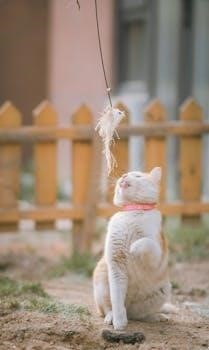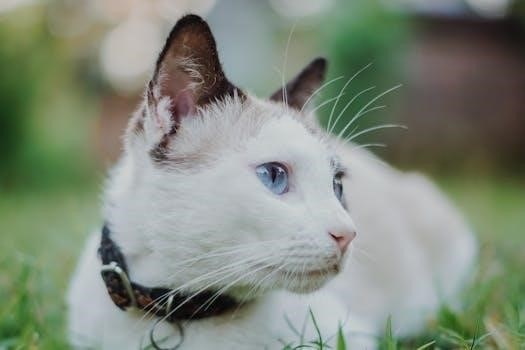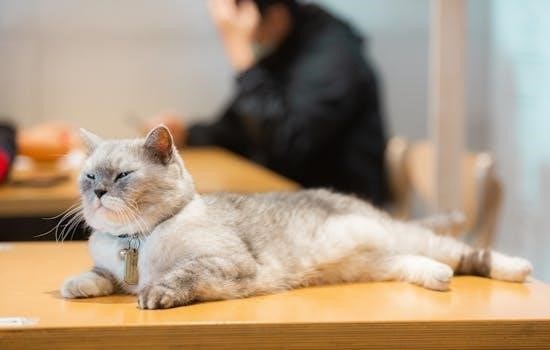Selecting the correct collar size is crucial for your cat’s safety and comfort. A collar that’s too tight can cause discomfort‚ while a loose one could easily slip off. This guide helps ensure the perfect fit.
Importance of Correct Collar Size
The right collar fit is paramount for your cat’s well-being. A collar that’s too snug can lead to choking‚ skin irritation‚ or even hair loss around the neck area due to constant rubbing. Conversely‚ a collar that’s too loose poses a safety risk‚ as your cat could get caught on something or easily slip out of it‚ potentially leading to them becoming lost or injured. A correctly fitted collar should allow for comfortable wear while securely holding identification tags. It ensures your cat can move freely‚ breathe easily‚ and remain safe‚ whether they are indoors or exploring outside. Proper sizing prevents common problems and allows your cat to enjoy wearing a collar without any discomfort or danger‚ making it an essential part of responsible pet ownership.

Measuring Your Cat’s Neck
Accurate measurement is key to a comfortable and safe collar. Using a flexible tape or string‚ measure around the widest part of your cat’s neck.
Using a Measuring Tape or String
To accurately measure your cat’s neck for a collar‚ you can use either a flexible measuring tape or a piece of string. If using a measuring tape‚ gently wrap it around your cat’s neck where the collar would naturally sit‚ ensuring it’s snug but not tight. Note the measurement. If you’re using string‚ wrap it around the neck and mark the point where the ends meet‚ then lay the string on a ruler or tape measure to get the length. This will give you the precise neck circumference needed to determine the correct collar size. Remember‚ accuracy is vital for your cat’s comfort.
Ensuring Proper Fit⁚ The Two-Finger Rule
After measuring your cat’s neck and choosing a collar‚ it’s essential to check the fit. A good rule of thumb is the “two-finger rule.” Once the collar is fastened around your cat’s neck‚ you should be able to comfortably slip two fingers between the collar and your cat’s skin. If you can fit more than two fingers‚ the collar is too loose and might slip off. If you can’t fit two fingers‚ it’s too tight and could cause discomfort or even injury. This ensures the collar is snug enough to stay on but loose enough to allow for comfortable movement and breathing. Regularly check the fit‚ especially for growing kittens‚ to ensure continued comfort and safety.

Understanding Collar Sizes
Cat collars come in various sizes‚ typically categorized as kitten‚ adult‚ and large. Adjustable lengths and breakaway buckles are important features to consider for safety and comfort.
Common Cat Collar Sizes⁚ Kitten‚ Adult‚ Large
Kitten collars are designed for smaller necks‚ typically around 7-8 inches (18-20cm) and are very adjustable‚ focusing on lighter weight materials. Adult cat collars usually fit necks between 8-12 inches (20-30cm)‚ accommodating average sized cats. Large cat collars are for bigger breeds like Maine Coons‚ often ranging from 10-13 inches (26-31cm) and are sometimes made from more robust materials. It’s important to note that some brands may have slight size variations‚ and that weight can be a deciding factor for some brands. Always measure your cat to be sure of the most suitable size‚ and consider adjustable designs for growing pets.
Adjustable Lengths and Breakaway Buckles
Many cat collars feature adjustable lengths‚ allowing for a customized fit as your cat grows or fluctuates in weight. This adjustability is vital to ensure a snug‚ but not tight‚ fit. Breakaway buckles are a critical safety feature‚ designed to release under pressure if the collar gets snagged‚ preventing potential choking hazards. These buckles are especially important for cats that roam outdoors‚ and are recommended by many vets and cat experts. Most collars will have a few holes spaced evenly apart for adjustment. When choosing‚ ensure the collar is easily adjustable but stays secure‚ providing both comfort and safety for your feline friend.

Specific Brand Size Charts
Different brands often have unique sizing‚ so always check their specific size charts. These charts help determine the right collar length based on measurements or cat weight‚ ensuring the best fit.
Checking Online for Brand-Specific Guides
When selecting a cat collar‚ it’s essential to recognize that sizing can vary significantly between different brands; Therefore‚ it’s always a good practice to seek out and consult the specific size guides provided by the manufacturer. Many brands‚ particularly those specializing in pet accessories‚ will have detailed size charts readily available on their websites. These guides often include measurements‚ weight ranges‚ and sometimes even breed-specific recommendations to assist you in finding the ideal fit for your feline companion. Checking these guides before making a purchase can save you time and ensure you avoid the inconvenience of returns or exchanges. Always prioritize using brand-specific guides over generic size charts to ensure the perfect size.
Weight-Based Sizing Charts
Weight-based sizing charts offer another method for determining the correct cat collar size. These charts often correlate your cat’s weight with a suggested collar size. They are particularly useful when measuring your cat’s neck directly is challenging‚ such as with very active or less cooperative felines. However‚ remember that these charts offer a general guideline‚ and individual variations such as fur thickness or body build can affect the accuracy. For example‚ a cat of a specific weight with very thick fur may require a size larger than suggested by the chart. Always use weight-based sizing charts as a preliminary guide and supplement this information with other fitting methods to ensure the best fit. Always prioritize your cat’s comfort and safety.
Collar Types and Sizing
Different collar types‚ such as breakaway and non-breakaway‚ impact sizing. Width and material also play a crucial role in ensuring both comfort and functionality for your cat.
Width Options for Different Cat Sizes
When selecting a cat collar‚ the width is an important factor‚ not just for aesthetics‚ but also for comfort and safety. For smaller cats and kittens‚ a narrower collar width is often more suitable. A width of around 1cm or 0.4 inches is often ideal‚ preventing the collar from feeling too bulky or cumbersome. This is also suitable for slender or petite cats. Conversely‚ larger breeds or cats with more robust builds may benefit from a slightly wider collar to ensure the weight is distributed evenly‚ typically around 1.5 cm. It is crucial to ensure that the collar is not so wide that it restricts the cat’s movement or causes irritation. Always choose a width that is proportional to your cat’s size and build;
Breakaway vs. Non-Breakaway Collars
Choosing between breakaway and non-breakaway collars is essential for your cat’s safety. Breakaway collars are designed with a buckle that will release under pressure‚ preventing your cat from getting caught on something and potentially injuring itself. These are the recommended option for most cats‚ especially those that spend time outdoors. Non-breakaway collars‚ on the other hand‚ do not release under pressure‚ which means they are not designed to detach. These are generally less safe for cats‚ as they pose a greater risk of entanglement. For safety reasons‚ breakaway collars are generally the preferred choice for cats‚ minimizing the risk of accidents or injuries.

Additional Sizing Considerations
When sizing a collar‚ remember to account for your cat’s fur thickness and growth‚ especially with kittens. Regular adjustments might be needed to maintain a safe and comfortable fit.
Adjusting for Fur Thickness
A cat’s fur can significantly impact collar fit‚ especially for breeds with long or thick coats. When measuring‚ compress the fur slightly to get a more accurate neck circumference. For cats with particularly fluffy fur‚ add about half an inch to your measurement to ensure the collar isn’t too snug. It is essential to check the fit regularly‚ as fur thickness can change with the seasons and grooming. Always ensure you can comfortably fit two fingers between the collar and your cat’s neck‚ even after adjusting for fur. This will prevent discomfort while ensuring the collar stays on securely. Do not forget that accurate measurements are important for your cats comfort.
Accounting for Growth (Kittens)
Kittens grow rapidly‚ so regular collar adjustments are essential. When selecting a collar for a kitten‚ opt for one that has adjustable sizing to accommodate their growth spurts. Measure your kitten’s neck frequently‚ and remember to check the fit every couple of weeks. It is very important that you should not select a collar that fits snugly at the time of purchase‚ as it will quickly become too tight. Opt for a collar that allows room for growth‚ ensuring you can easily fit two fingers between the collar and the kitten’s neck. Remember that regular adjustments are necessary for safety and comfort as they grow.
Troubleshooting Common Issues
Inaccurate measurements or improper adjustments can lead to safety concerns. Learn to handle these issues for the comfort and well-being of your cat‚ and ensure proper fit.
Dealing with Inaccurate Measurements
Measuring your cat’s neck can sometimes be tricky‚ often leading to inaccurate results. If you find your measurements are inconsistent‚ use a piece of string to measure‚ then lay it against a ruler for greater accuracy. Always err on the side of a slightly looser fit‚ ensuring that you can easily slip two fingers under the collar. Re-measure if needed‚ especially if you’re using a different measuring method. If you are still unsure‚ consider checking the specific brand size chart online for detailed guidance‚ as they may offer specific advice based on their product design‚ or even weight based recommendations. The goal is a secure and comfortable collar for your feline friend.
Adjusting Collars for Safety and Comfort
Proper adjustment is key to both safety and comfort. A correctly fitted collar should be snug‚ but not restrictive‚ allowing you to slide two fingers comfortably between the collar and your cat’s neck. Regularly check the fit of the collar‚ especially for kittens or cats with thick fur‚ as they can grow or change in size quickly. If the collar appears too tight‚ loosen it; if it seems too loose‚ tighten it to prevent escape or snagging on objects. Always prioritize a breakaway buckle for safety‚ and ensure no part of the collar interferes with the cat’s movement or breathing. This will ensure your cat is both secure and comfortable at all times.